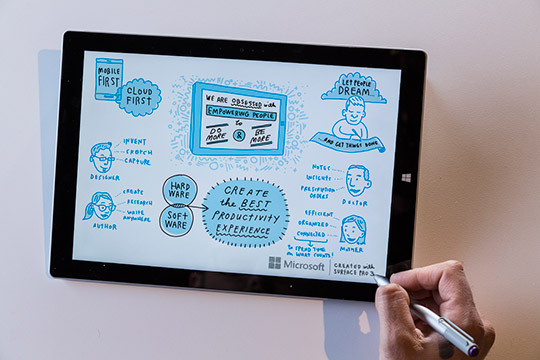Sony’s position, however, is more complex than Samsung’s as it has been a player in content for years, giving it the benefit of aggressive product placement in its feature films. This backfired with this summer’s blockbuster The Amazing Spiderman 2 where Vaio laptops featured prominently.
If Sony and Samsung attempts at fostering ecosystems are down by poor messaging or recognisable leadership, Microsoft has the opposite problem: strong messaging and inconsistent products.
Steve Ballmer’s attempt to redefine Microsoft as a devices and services company produced a number of failed products (the Zune and Kin, for starters) before the Surface RT and Surface Pro landed, the former being a $900 million bomb. With Ballmer gone, current CEO Satya Nadella tried to turn a dud tablet strategy around with the Surface Pro 3. With Nadella as a figurehead and his ‘cloud first, mobile first’ paradigm, we can see that even if Microsoft can’t innovate it knows where it needs to be.
With the Surface RT all but forgotten and an 8” Surface dropped at the last second, the Surface Pro 3 has a clear run with its ‘only machine you need’ marketing. The investment in using Core processors, new screen technology and lighter materials makes the Aurface Pro 3 the most exciting tablet we’ve seen but its specs create an issue of pricing. Starting at €819, the Pro 3 bypasses the tablet market (where the iPad Air starts at €489) to compete with ultrabook PCs and the Macbook Air (which start at €929) or, rather, it competes with the combined price of an ultrabook and a tablet.
Peripherals
Had the Surface Pro 3 been an all-new product this message would be fine, but this is the third shot Redmond has had at making the Surface Pro a compelling proposition and, despite the first two iterations being as impressive for their time, reframing it as the new face of the ‘all in one PC’ isn’t going to work not because of the Pro 3 itself but because of a lack of peripherals (an area Microsoft is otherwise strong in) doesn’t give it that flexibility to be all those things to all people.
When demonstrating improvements in the Surface Pro 3’s stability as a laptop replacement, Panay still looked awkward with revised type cover and angled kickstand. Even worse, the Pro 3 looked ugly when put in a keyboard dock and despite an endorsement from Adobe, unless you’re seeing Photoshop live at work on a high definition monitor, its graphics capability is a moot point. Without a compelling range of complimentary hardware, the Pro 3 is a versatile 12” tablet at a PC price point.
This is not to know the Surface Pro. As a satisfied user of one I’m frustrated by the lack of peripherals and consider it one of the main things holding it back, especially in building upon the user experience. In trying to look innovative Microsoft has released a product that requires a leap for the casual user. A ‘best of both worlds’ message is fine so long as those worlds are recognisable in the first place – floppy keypads, small screens and kickstands will not convert shoppers looking for a general purpose laptop or home PC.
The Dell XPS 10 showed that tablet/laptop hybrids could be done well and had it come with a full version of Windows 8 instead of RT it would be the device the Surface Pro needs to be.
Microsoft has the PC market sewn up with Windows but its cache doesn’t spread beyond software. Despite succeeding where Sony and Samsung struggle, by putting its faith in an expensive product that tries to mould user expectations to suit its product, Microsoft’s tablet strategy will fail.
Samsung, Sony and Microsoft have plenty of good products but overreach is leading to costly product failures and diluted brand value. Ecosystems are created by solid products and customer loyalty, solidified by a set of creative ‘values’ and a cult of personality. Sometimes it’s not worth the effort.








Subscribers 0
Fans 0
Followers 0
Followers